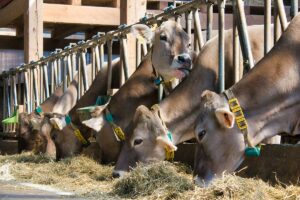Alvaro Garcia
Hot summer temperatures are a highly limiting factor for milk production of dairy cows. To maintain body temperature, cows reduce intake, which decreases the heat increment that results from rumen fermentation. In order to improve milk production under these conditions it is necessary to restore intake, and/or improve nutrient digestibility. Since forage fiber requires more time for its degradation in the rumen, it produces more heat of fermentation than concentrates.
Less fiber in the diet however, results in less chewing, reduced saliva production, more grain fermentation, and ultimately a more acidic rumen pH. These changes shift the pattern of fermentation from predominantly acetate to propionate→lactate, risking the appearance of sub-clinical or clinical rumen acidosis. Past research has demonstrated that feeding live yeasts or yeast cultures increases milk production of cows under heat stress.
Could Saccharomyces cerevisiae help cows under heat stress?
A recent study conducted at the University of Florida (Perdomo et al., 2020) evaluated the inclusion in the diet of rumen-specific live yeasts to improve nutrient digestion, rumen function, and performance of early lactation dairy cows under heat stress. The yeast selected was Saccharomyces cerevisiae, which is well known for its carbohydrate fermentation properties, and is commonly used as feed additive for ruminants.
Its proposed mechanism of action is as a scavenger of oxygen in the rumen thus reducing the redox potential, which enhances the activity of cellulolytic and lactate-utilizing bacteria. It has also been proposed that the increased rumen pH results from changes in the patterns of feed intake and feeding behavior, with increased meal frequency, which possibly alleviates the acid load in the rumen. In this experiment cows in their first 20 days in milk (DIM) were blocked by parity and milk yield and assigned from 30 to 107 DIM to the following three treatments:
- Control (0 yeast)
- 0.5, g/day of live yeast (14.2 billion cells)*
- 1.0 g/day of live yeast (37.6 billion cells)*
*Saccharomyces cerevisiae strain CNCM I-1077.
Improvement in milk production, feed conversion, diet digestibility, and ruminal pH
Mean ambient temperature was 26.8 °C, and humidity 83.2%; temperature and humidity index ranged from 73 to 81. Milking was twice a day, dry matter intakes and milk yields were measured daily, while milk components weekly.
Yeast inclusion in the diets did not affect rectal temperatures (38.9 ± 0.04 °C) or dry matter intakes but it did increase yield of energy-corrected milk (35.2 vs. 36.1 vs. 37.2 kg/day for 0, 0.5, and 1.0 g/day, respectively). As a result, the efficiency of conversion of dry matter into energy corrected milk was also altered (1.70, 1.79, and 1.83 for 0, 0.5, and 1 g/d, respectively).
Feeding live yeast increased the digestibility of crude protein (65.1 vs. 68.8 vs. 70.4%) and neutral detergent fiber (47.5 vs. 49.2 vs. 55.2%), and the concentration of acetate (64.7 vs. 69.1 vs. 72.2 mM). The changes in ruminal acetate concentrations resulted in higher concentrations of short chain fatty acids in rumen fluid (110.3 vs. 117.7 vs. 121.4 mM).
The pH of the rumen fluid increased (5.99 vs. 6.03 vs. 6.26) with the addition of live yeast. Concomitantly, the proportion of cows with pH under 5.8 decreased (42.9 vs. 34.9 vs. 7.7%) as the inclusion of live yeast in the diet increased.
Meal size was reduced quadratically (3.2, 3.5, and 2.9 kg of DM, respectively), interval between rumination episodes however tended to reduce linearly (122, 96.5, and 90.7 min, respectively) as live yeast increased in the diet. Chewing time per kilogram of neutral detergent fiber tended to increase linearly (71.6, 71.3, and 81.6 min/kg, respectively) as the yeast in the diet increased. Estimation of the net energy for lactation of the diet resulted in an increase of 5.2%, from 1.72 Mcal/kg of DM for the control diet to 1.81 Mcal/kg with 1 g of live yeast.
In summary, feeding 1 g of live yeast per day to cows under heat stress increased yield of energy corrected milk and the efficiency of feed conversion. Diet digestibility, and ruminal fluid pH also increased which can be attributed to effects of the Saccharomyces cerevisiae on ruminal microbial activity or possibly changes in feeding behavior that resulted in improved digestibility.
Reference
Perdomo, M.C., Marsola, R.S., Favoreto, M.G., Adesogan, A., Staples, C.R., Santos, J.E.P. 2020. Effects of feeding live yeast at 2 dosages on performance and feeding behavior of dairy cows under heat stress. Journal of dairy science. 103(1): 325-339.
© 2020 Dairy Knowledge Center. All Rights Reserved.










